Case Study: Contemporary Challenges of Health Inequalities in the UK
VerifiedAdded on 2023/06/13
|10
|3461
|371
Report
AI Summary
This report examines the contemporary challenge of health inequalities within the UK's health and social care system. It highlights the disparities in health outcomes among different population groups, particularly those with low incomes and ethnic minorities. The report uses statistical data to illustrate the widening gap in life expectancy and healthy life expectancy between the most and least deprived areas. It explores the socioeconomic factors, such as income, gender, and ethnicity, that contribute to these inequalities. Furthermore, the report evaluates theories and solutions proposed by public health leaders and healthcare professionals, emphasizing the importance of addressing social determinants of health to promote health equity. The aim is to provide a comprehensive understanding of the issue and potential strategies for improvement within the UK healthcare landscape.
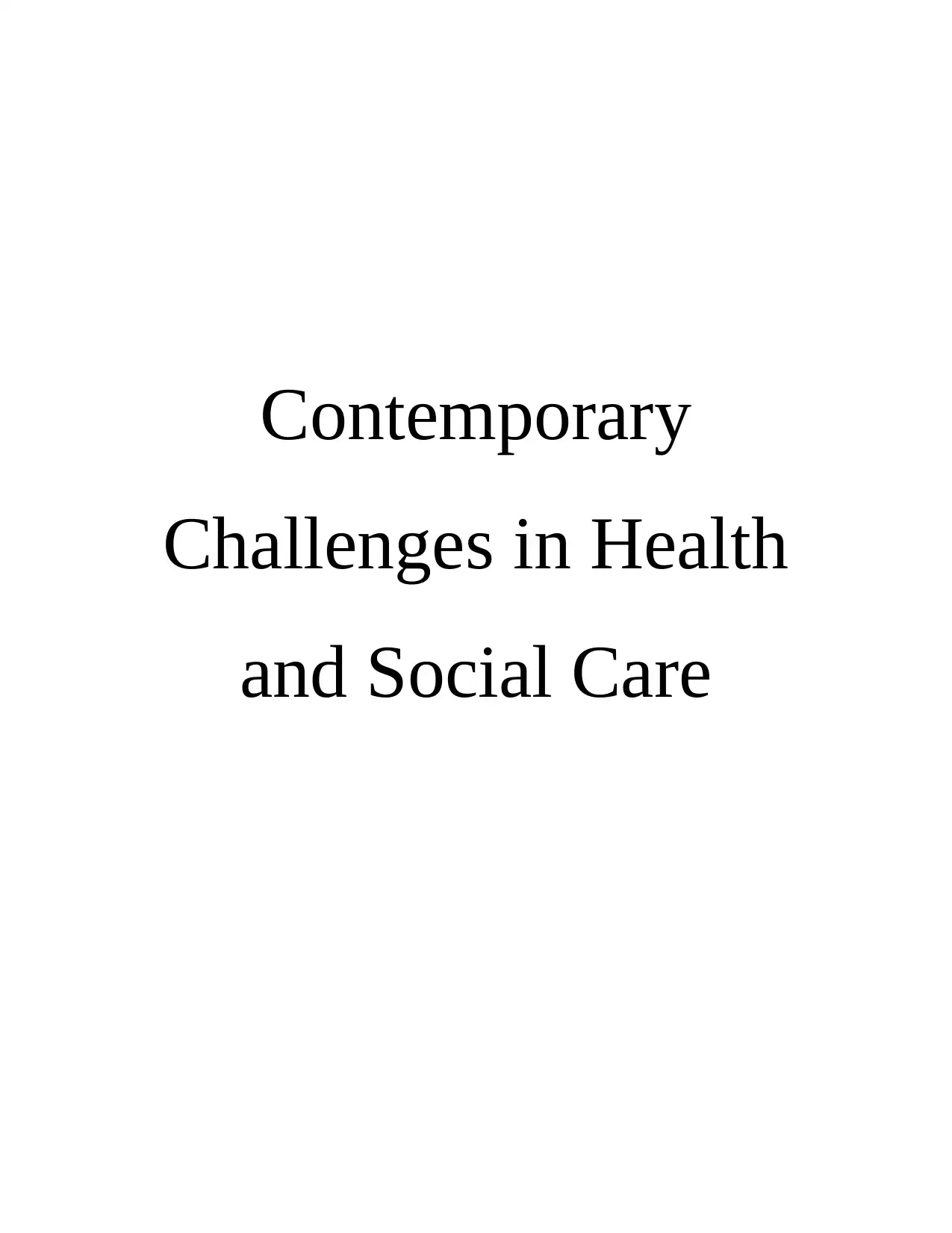
Contemporary
Challenges in Health
and Social Care
Challenges in Health
and Social Care
Paraphrase This Document
Need a fresh take? Get an instant paraphrase of this document with our AI Paraphraser
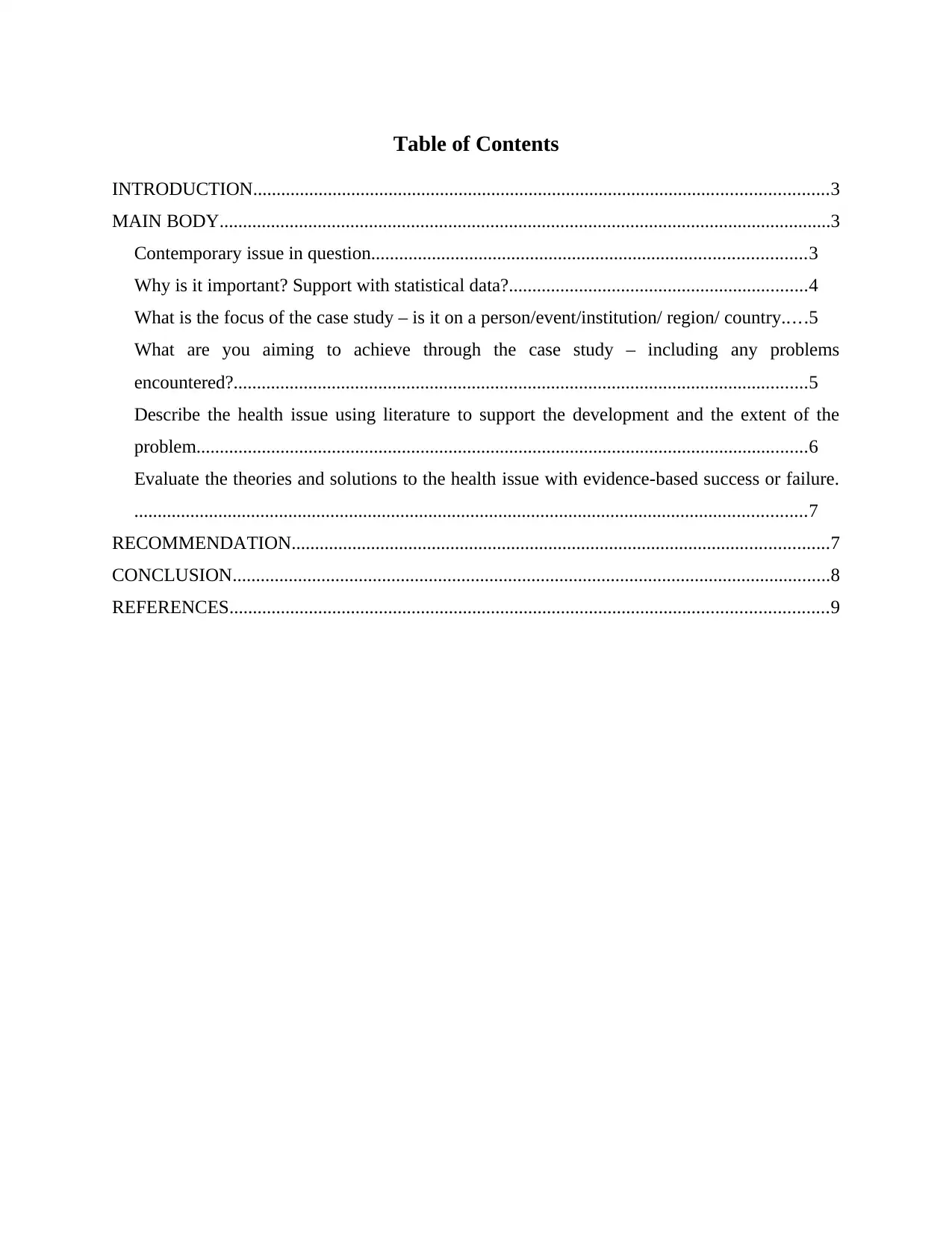
Table of Contents
INTRODUCTION...........................................................................................................................3
MAIN BODY...................................................................................................................................3
Contemporary issue in question.............................................................................................3
Why is it important? Support with statistical data?................................................................4
What is the focus of the case study – is it on a person/event/institution/ region/ country.....5
What are you aiming to achieve through the case study – including any problems
encountered?...........................................................................................................................5
Describe the health issue using literature to support the development and the extent of the
problem...................................................................................................................................6
Evaluate the theories and solutions to the health issue with evidence-based success or failure.
................................................................................................................................................7
RECOMMENDATION...................................................................................................................7
CONCLUSION................................................................................................................................8
REFERENCES................................................................................................................................9
INTRODUCTION...........................................................................................................................3
MAIN BODY...................................................................................................................................3
Contemporary issue in question.............................................................................................3
Why is it important? Support with statistical data?................................................................4
What is the focus of the case study – is it on a person/event/institution/ region/ country.....5
What are you aiming to achieve through the case study – including any problems
encountered?...........................................................................................................................5
Describe the health issue using literature to support the development and the extent of the
problem...................................................................................................................................6
Evaluate the theories and solutions to the health issue with evidence-based success or failure.
................................................................................................................................................7
RECOMMENDATION...................................................................................................................7
CONCLUSION................................................................................................................................8
REFERENCES................................................................................................................................9
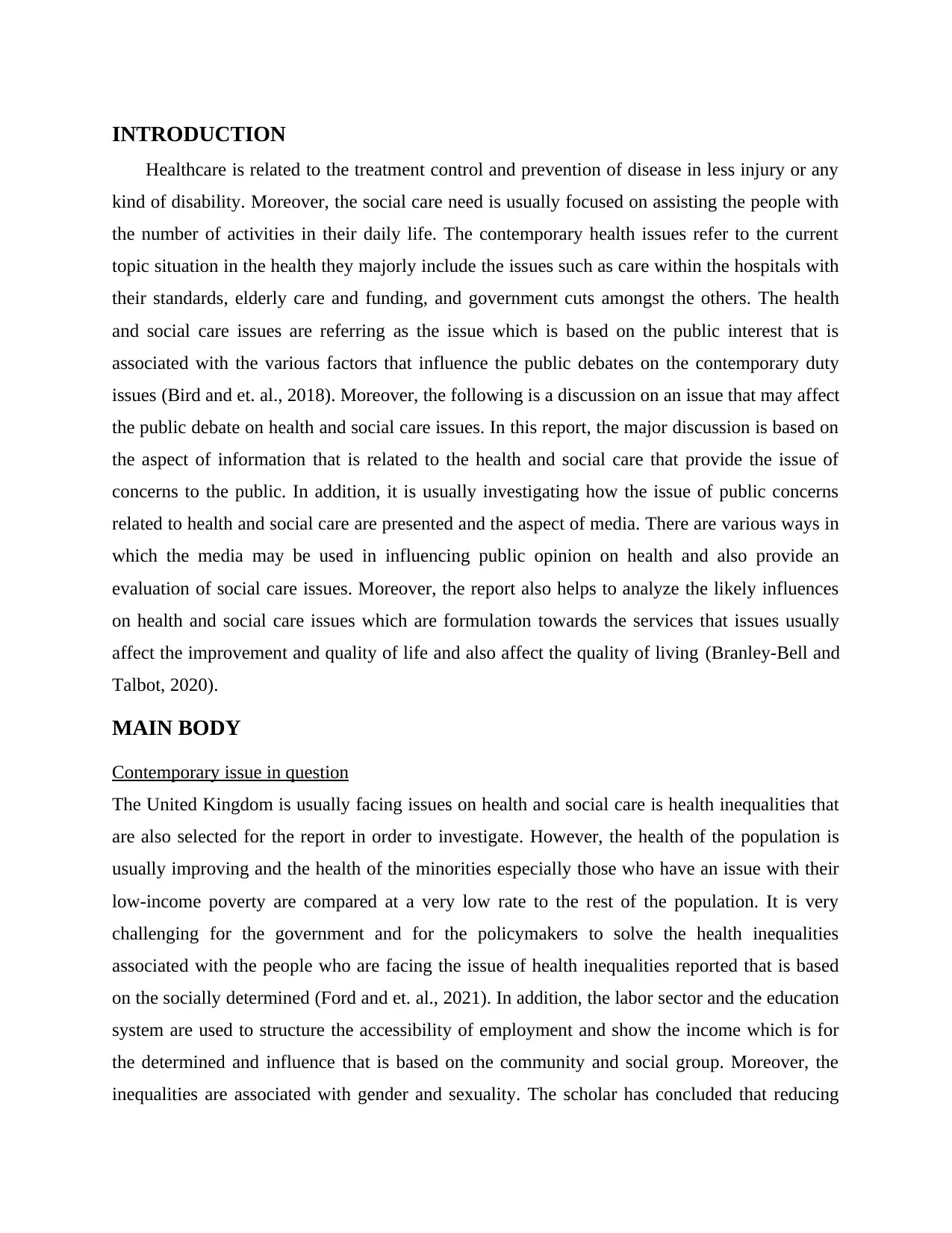
INTRODUCTION
Healthcare is related to the treatment control and prevention of disease in less injury or any
kind of disability. Moreover, the social care need is usually focused on assisting the people with
the number of activities in their daily life. The contemporary health issues refer to the current
topic situation in the health they majorly include the issues such as care within the hospitals with
their standards, elderly care and funding, and government cuts amongst the others. The health
and social care issues are referring as the issue which is based on the public interest that is
associated with the various factors that influence the public debates on the contemporary duty
issues (Bird and et. al., 2018). Moreover, the following is a discussion on an issue that may affect
the public debate on health and social care issues. In this report, the major discussion is based on
the aspect of information that is related to the health and social care that provide the issue of
concerns to the public. In addition, it is usually investigating how the issue of public concerns
related to health and social care are presented and the aspect of media. There are various ways in
which the media may be used in influencing public opinion on health and also provide an
evaluation of social care issues. Moreover, the report also helps to analyze the likely influences
on health and social care issues which are formulation towards the services that issues usually
affect the improvement and quality of life and also affect the quality of living (Branley-Bell and
Talbot, 2020).
MAIN BODY
Contemporary issue in question
The United Kingdom is usually facing issues on health and social care is health inequalities that
are also selected for the report in order to investigate. However, the health of the population is
usually improving and the health of the minorities especially those who have an issue with their
low-income poverty are compared at a very low rate to the rest of the population. It is very
challenging for the government and for the policymakers to solve the health inequalities
associated with the people who are facing the issue of health inequalities reported that is based
on the socially determined (Ford and et. al., 2021). In addition, the labor sector and the education
system are used to structure the accessibility of employment and show the income which is for
the determined and influence that is based on the community and social group. Moreover, the
inequalities are associated with gender and sexuality. The scholar has concluded that reducing
Healthcare is related to the treatment control and prevention of disease in less injury or any
kind of disability. Moreover, the social care need is usually focused on assisting the people with
the number of activities in their daily life. The contemporary health issues refer to the current
topic situation in the health they majorly include the issues such as care within the hospitals with
their standards, elderly care and funding, and government cuts amongst the others. The health
and social care issues are referring as the issue which is based on the public interest that is
associated with the various factors that influence the public debates on the contemporary duty
issues (Bird and et. al., 2018). Moreover, the following is a discussion on an issue that may affect
the public debate on health and social care issues. In this report, the major discussion is based on
the aspect of information that is related to the health and social care that provide the issue of
concerns to the public. In addition, it is usually investigating how the issue of public concerns
related to health and social care are presented and the aspect of media. There are various ways in
which the media may be used in influencing public opinion on health and also provide an
evaluation of social care issues. Moreover, the report also helps to analyze the likely influences
on health and social care issues which are formulation towards the services that issues usually
affect the improvement and quality of life and also affect the quality of living (Branley-Bell and
Talbot, 2020).
MAIN BODY
Contemporary issue in question
The United Kingdom is usually facing issues on health and social care is health inequalities that
are also selected for the report in order to investigate. However, the health of the population is
usually improving and the health of the minorities especially those who have an issue with their
low-income poverty are compared at a very low rate to the rest of the population. It is very
challenging for the government and for the policymakers to solve the health inequalities
associated with the people who are facing the issue of health inequalities reported that is based
on the socially determined (Ford and et. al., 2021). In addition, the labor sector and the education
system are used to structure the accessibility of employment and show the income which is for
the determined and influence that is based on the community and social group. Moreover, the
inequalities are associated with gender and sexuality. The scholar has concluded that reducing
⊘ This is a preview!⊘
Do you want full access?
Subscribe today to unlock all pages.

Trusted by 1+ million students worldwide
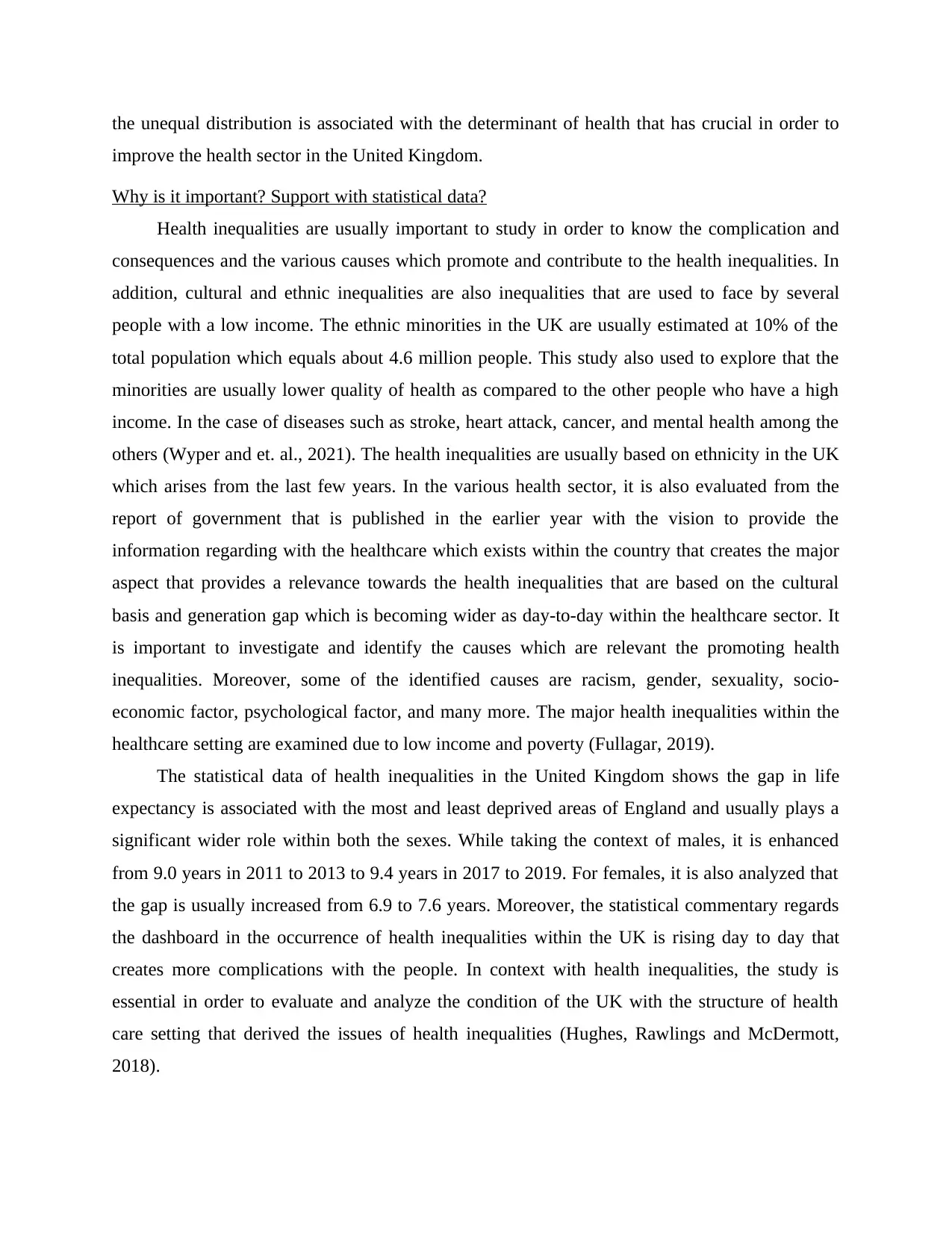
the unequal distribution is associated with the determinant of health that has crucial in order to
improve the health sector in the United Kingdom.
Why is it important? Support with statistical data?
Health inequalities are usually important to study in order to know the complication and
consequences and the various causes which promote and contribute to the health inequalities. In
addition, cultural and ethnic inequalities are also inequalities that are used to face by several
people with a low income. The ethnic minorities in the UK are usually estimated at 10% of the
total population which equals about 4.6 million people. This study also used to explore that the
minorities are usually lower quality of health as compared to the other people who have a high
income. In the case of diseases such as stroke, heart attack, cancer, and mental health among the
others (Wyper and et. al., 2021). The health inequalities are usually based on ethnicity in the UK
which arises from the last few years. In the various health sector, it is also evaluated from the
report of government that is published in the earlier year with the vision to provide the
information regarding with the healthcare which exists within the country that creates the major
aspect that provides a relevance towards the health inequalities that are based on the cultural
basis and generation gap which is becoming wider as day-to-day within the healthcare sector. It
is important to investigate and identify the causes which are relevant the promoting health
inequalities. Moreover, some of the identified causes are racism, gender, sexuality, socio-
economic factor, psychological factor, and many more. The major health inequalities within the
healthcare setting are examined due to low income and poverty (Fullagar, 2019).
The statistical data of health inequalities in the United Kingdom shows the gap in life
expectancy is associated with the most and least deprived areas of England and usually plays a
significant wider role within both the sexes. While taking the context of males, it is enhanced
from 9.0 years in 2011 to 2013 to 9.4 years in 2017 to 2019. For females, it is also analyzed that
the gap is usually increased from 6.9 to 7.6 years. Moreover, the statistical commentary regards
the dashboard in the occurrence of health inequalities within the UK is rising day to day that
creates more complications with the people. In context with health inequalities, the study is
essential in order to evaluate and analyze the condition of the UK with the structure of health
care setting that derived the issues of health inequalities (Hughes, Rawlings and McDermott,
2018).
improve the health sector in the United Kingdom.
Why is it important? Support with statistical data?
Health inequalities are usually important to study in order to know the complication and
consequences and the various causes which promote and contribute to the health inequalities. In
addition, cultural and ethnic inequalities are also inequalities that are used to face by several
people with a low income. The ethnic minorities in the UK are usually estimated at 10% of the
total population which equals about 4.6 million people. This study also used to explore that the
minorities are usually lower quality of health as compared to the other people who have a high
income. In the case of diseases such as stroke, heart attack, cancer, and mental health among the
others (Wyper and et. al., 2021). The health inequalities are usually based on ethnicity in the UK
which arises from the last few years. In the various health sector, it is also evaluated from the
report of government that is published in the earlier year with the vision to provide the
information regarding with the healthcare which exists within the country that creates the major
aspect that provides a relevance towards the health inequalities that are based on the cultural
basis and generation gap which is becoming wider as day-to-day within the healthcare sector. It
is important to investigate and identify the causes which are relevant the promoting health
inequalities. Moreover, some of the identified causes are racism, gender, sexuality, socio-
economic factor, psychological factor, and many more. The major health inequalities within the
healthcare setting are examined due to low income and poverty (Fullagar, 2019).
The statistical data of health inequalities in the United Kingdom shows the gap in life
expectancy is associated with the most and least deprived areas of England and usually plays a
significant wider role within both the sexes. While taking the context of males, it is enhanced
from 9.0 years in 2011 to 2013 to 9.4 years in 2017 to 2019. For females, it is also analyzed that
the gap is usually increased from 6.9 to 7.6 years. Moreover, the statistical commentary regards
the dashboard in the occurrence of health inequalities within the UK is rising day to day that
creates more complications with the people. In context with health inequalities, the study is
essential in order to evaluate and analyze the condition of the UK with the structure of health
care setting that derived the issues of health inequalities (Hughes, Rawlings and McDermott,
2018).
Paraphrase This Document
Need a fresh take? Get an instant paraphrase of this document with our AI Paraphraser
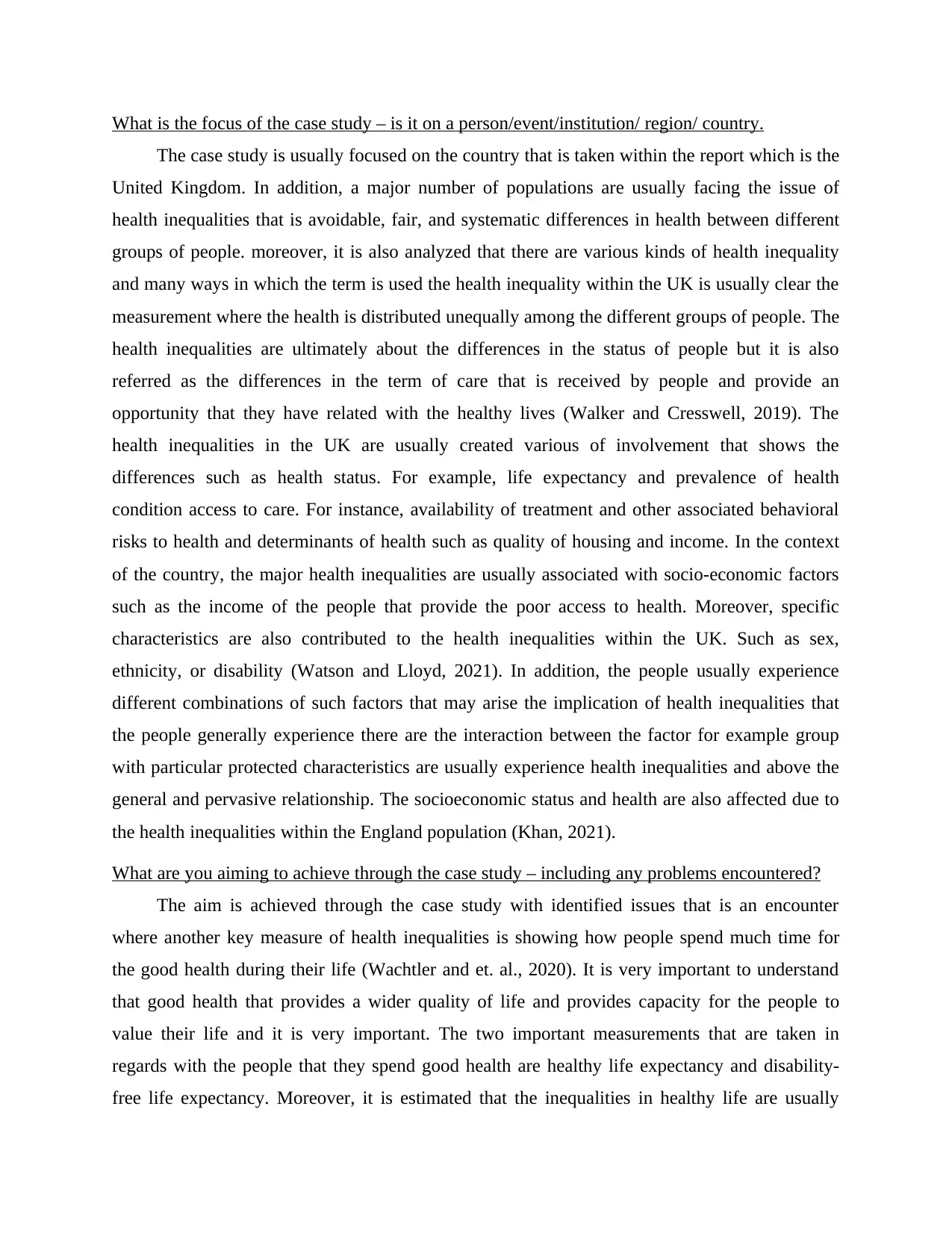
What is the focus of the case study – is it on a person/event/institution/ region/ country.
The case study is usually focused on the country that is taken within the report which is the
United Kingdom. In addition, a major number of populations are usually facing the issue of
health inequalities that is avoidable, fair, and systematic differences in health between different
groups of people. moreover, it is also analyzed that there are various kinds of health inequality
and many ways in which the term is used the health inequality within the UK is usually clear the
measurement where the health is distributed unequally among the different groups of people. The
health inequalities are ultimately about the differences in the status of people but it is also
referred as the differences in the term of care that is received by people and provide an
opportunity that they have related with the healthy lives (Walker and Cresswell, 2019). The
health inequalities in the UK are usually created various of involvement that shows the
differences such as health status. For example, life expectancy and prevalence of health
condition access to care. For instance, availability of treatment and other associated behavioral
risks to health and determinants of health such as quality of housing and income. In the context
of the country, the major health inequalities are usually associated with socio-economic factors
such as the income of the people that provide the poor access to health. Moreover, specific
characteristics are also contributed to the health inequalities within the UK. Such as sex,
ethnicity, or disability (Watson and Lloyd, 2021). In addition, the people usually experience
different combinations of such factors that may arise the implication of health inequalities that
the people generally experience there are the interaction between the factor for example group
with particular protected characteristics are usually experience health inequalities and above the
general and pervasive relationship. The socioeconomic status and health are also affected due to
the health inequalities within the England population (Khan, 2021).
What are you aiming to achieve through the case study – including any problems encountered?
The aim is achieved through the case study with identified issues that is an encounter
where another key measure of health inequalities is showing how people spend much time for
the good health during their life (Wachtler and et. al., 2020). It is very important to understand
that good health that provides a wider quality of life and provides capacity for the people to
value their life and it is very important. The two important measurements that are taken in
regards with the people that they spend good health are healthy life expectancy and disability-
free life expectancy. Moreover, it is estimated that the inequalities in healthy life are usually
The case study is usually focused on the country that is taken within the report which is the
United Kingdom. In addition, a major number of populations are usually facing the issue of
health inequalities that is avoidable, fair, and systematic differences in health between different
groups of people. moreover, it is also analyzed that there are various kinds of health inequality
and many ways in which the term is used the health inequality within the UK is usually clear the
measurement where the health is distributed unequally among the different groups of people. The
health inequalities are ultimately about the differences in the status of people but it is also
referred as the differences in the term of care that is received by people and provide an
opportunity that they have related with the healthy lives (Walker and Cresswell, 2019). The
health inequalities in the UK are usually created various of involvement that shows the
differences such as health status. For example, life expectancy and prevalence of health
condition access to care. For instance, availability of treatment and other associated behavioral
risks to health and determinants of health such as quality of housing and income. In the context
of the country, the major health inequalities are usually associated with socio-economic factors
such as the income of the people that provide the poor access to health. Moreover, specific
characteristics are also contributed to the health inequalities within the UK. Such as sex,
ethnicity, or disability (Watson and Lloyd, 2021). In addition, the people usually experience
different combinations of such factors that may arise the implication of health inequalities that
the people generally experience there are the interaction between the factor for example group
with particular protected characteristics are usually experience health inequalities and above the
general and pervasive relationship. The socioeconomic status and health are also affected due to
the health inequalities within the England population (Khan, 2021).
What are you aiming to achieve through the case study – including any problems encountered?
The aim is achieved through the case study with identified issues that is an encounter
where another key measure of health inequalities is showing how people spend much time for
the good health during their life (Wachtler and et. al., 2020). It is very important to understand
that good health that provides a wider quality of life and provides capacity for the people to
value their life and it is very important. The two important measurements that are taken in
regards with the people that they spend good health are healthy life expectancy and disability-
free life expectancy. Moreover, it is estimated that the inequalities in healthy life are usually
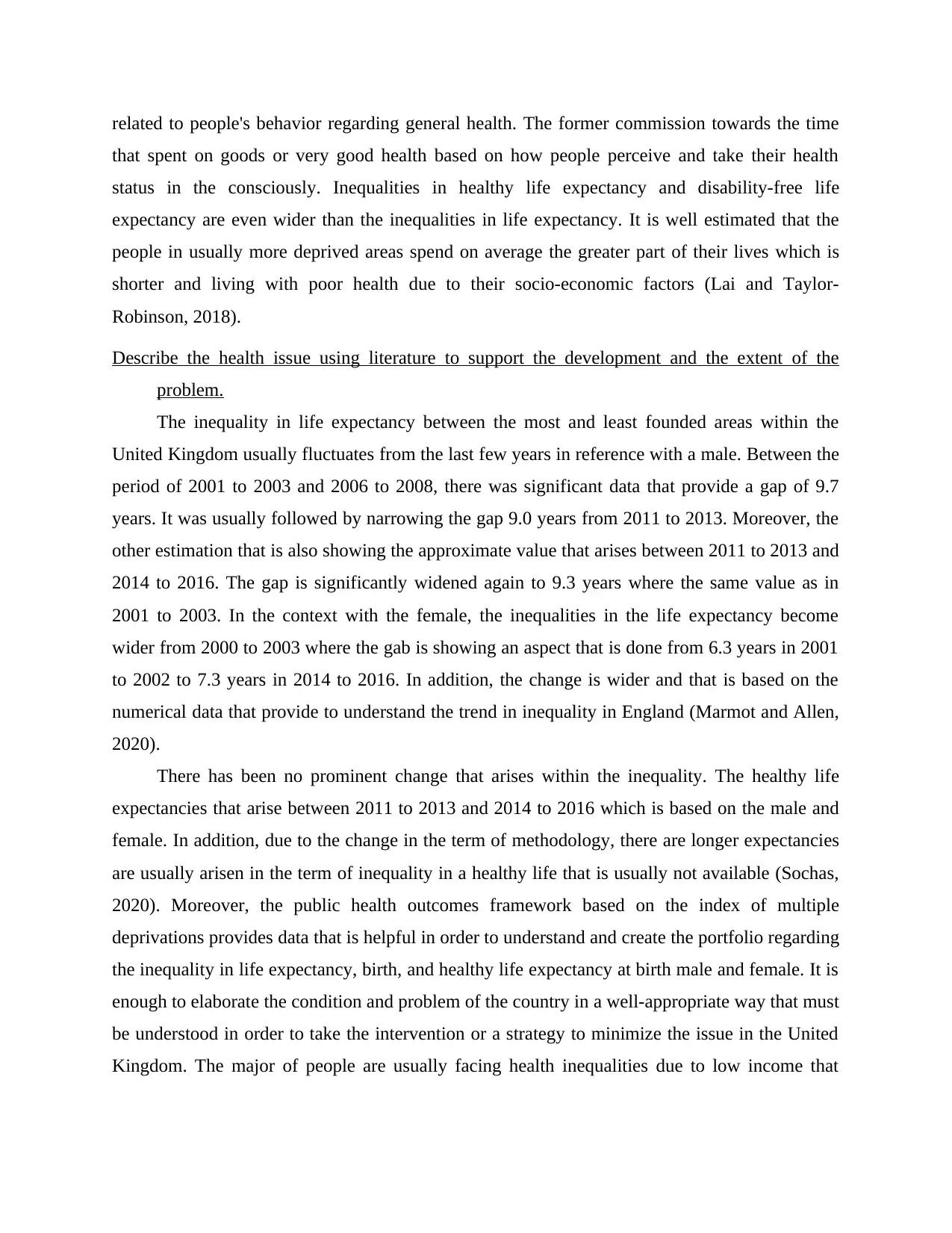
related to people's behavior regarding general health. The former commission towards the time
that spent on goods or very good health based on how people perceive and take their health
status in the consciously. Inequalities in healthy life expectancy and disability-free life
expectancy are even wider than the inequalities in life expectancy. It is well estimated that the
people in usually more deprived areas spend on average the greater part of their lives which is
shorter and living with poor health due to their socio-economic factors (Lai and Taylor-
Robinson, 2018).
Describe the health issue using literature to support the development and the extent of the
problem.
The inequality in life expectancy between the most and least founded areas within the
United Kingdom usually fluctuates from the last few years in reference with a male. Between the
period of 2001 to 2003 and 2006 to 2008, there was significant data that provide a gap of 9.7
years. It was usually followed by narrowing the gap 9.0 years from 2011 to 2013. Moreover, the
other estimation that is also showing the approximate value that arises between 2011 to 2013 and
2014 to 2016. The gap is significantly widened again to 9.3 years where the same value as in
2001 to 2003. In the context with the female, the inequalities in the life expectancy become
wider from 2000 to 2003 where the gab is showing an aspect that is done from 6.3 years in 2001
to 2002 to 7.3 years in 2014 to 2016. In addition, the change is wider and that is based on the
numerical data that provide to understand the trend in inequality in England (Marmot and Allen,
2020).
There has been no prominent change that arises within the inequality. The healthy life
expectancies that arise between 2011 to 2013 and 2014 to 2016 which is based on the male and
female. In addition, due to the change in the term of methodology, there are longer expectancies
are usually arisen in the term of inequality in a healthy life that is usually not available (Sochas,
2020). Moreover, the public health outcomes framework based on the index of multiple
deprivations provides data that is helpful in order to understand and create the portfolio regarding
the inequality in life expectancy, birth, and healthy life expectancy at birth male and female. It is
enough to elaborate the condition and problem of the country in a well-appropriate way that must
be understood in order to take the intervention or a strategy to minimize the issue in the United
Kingdom. The major of people are usually facing health inequalities due to low income that
that spent on goods or very good health based on how people perceive and take their health
status in the consciously. Inequalities in healthy life expectancy and disability-free life
expectancy are even wider than the inequalities in life expectancy. It is well estimated that the
people in usually more deprived areas spend on average the greater part of their lives which is
shorter and living with poor health due to their socio-economic factors (Lai and Taylor-
Robinson, 2018).
Describe the health issue using literature to support the development and the extent of the
problem.
The inequality in life expectancy between the most and least founded areas within the
United Kingdom usually fluctuates from the last few years in reference with a male. Between the
period of 2001 to 2003 and 2006 to 2008, there was significant data that provide a gap of 9.7
years. It was usually followed by narrowing the gap 9.0 years from 2011 to 2013. Moreover, the
other estimation that is also showing the approximate value that arises between 2011 to 2013 and
2014 to 2016. The gap is significantly widened again to 9.3 years where the same value as in
2001 to 2003. In the context with the female, the inequalities in the life expectancy become
wider from 2000 to 2003 where the gab is showing an aspect that is done from 6.3 years in 2001
to 2002 to 7.3 years in 2014 to 2016. In addition, the change is wider and that is based on the
numerical data that provide to understand the trend in inequality in England (Marmot and Allen,
2020).
There has been no prominent change that arises within the inequality. The healthy life
expectancies that arise between 2011 to 2013 and 2014 to 2016 which is based on the male and
female. In addition, due to the change in the term of methodology, there are longer expectancies
are usually arisen in the term of inequality in a healthy life that is usually not available (Sochas,
2020). Moreover, the public health outcomes framework based on the index of multiple
deprivations provides data that is helpful in order to understand and create the portfolio regarding
the inequality in life expectancy, birth, and healthy life expectancy at birth male and female. It is
enough to elaborate the condition and problem of the country in a well-appropriate way that must
be understood in order to take the intervention or a strategy to minimize the issue in the United
Kingdom. The major of people are usually facing health inequalities due to low income that
⊘ This is a preview!⊘
Do you want full access?
Subscribe today to unlock all pages.

Trusted by 1+ million students worldwide
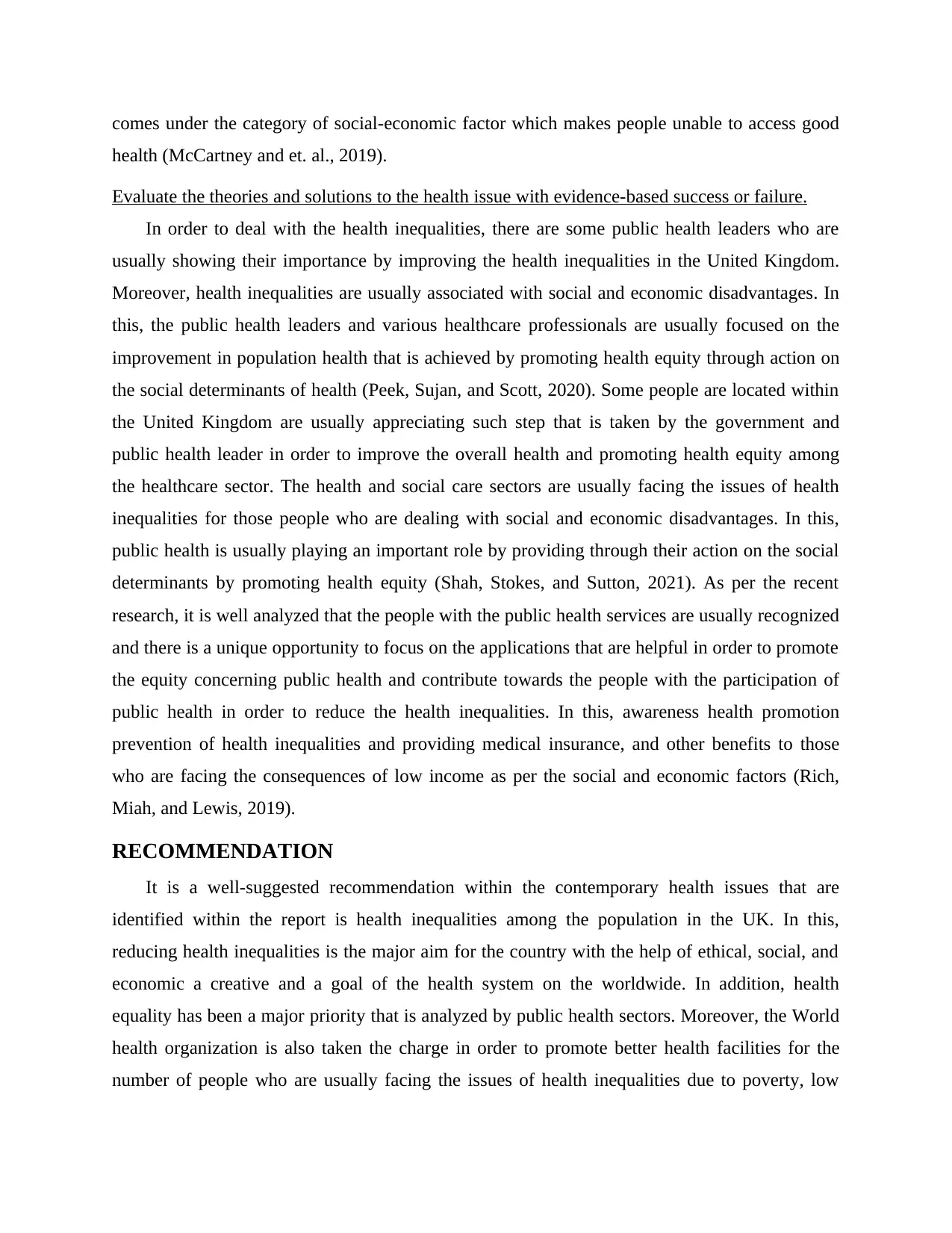
comes under the category of social-economic factor which makes people unable to access good
health (McCartney and et. al., 2019).
Evaluate the theories and solutions to the health issue with evidence-based success or failure.
In order to deal with the health inequalities, there are some public health leaders who are
usually showing their importance by improving the health inequalities in the United Kingdom.
Moreover, health inequalities are usually associated with social and economic disadvantages. In
this, the public health leaders and various healthcare professionals are usually focused on the
improvement in population health that is achieved by promoting health equity through action on
the social determinants of health (Peek, Sujan, and Scott, 2020). Some people are located within
the United Kingdom are usually appreciating such step that is taken by the government and
public health leader in order to improve the overall health and promoting health equity among
the healthcare sector. The health and social care sectors are usually facing the issues of health
inequalities for those people who are dealing with social and economic disadvantages. In this,
public health is usually playing an important role by providing through their action on the social
determinants by promoting health equity (Shah, Stokes, and Sutton, 2021). As per the recent
research, it is well analyzed that the people with the public health services are usually recognized
and there is a unique opportunity to focus on the applications that are helpful in order to promote
the equity concerning public health and contribute towards the people with the participation of
public health in order to reduce the health inequalities. In this, awareness health promotion
prevention of health inequalities and providing medical insurance, and other benefits to those
who are facing the consequences of low income as per the social and economic factors (Rich,
Miah, and Lewis, 2019).
RECOMMENDATION
It is a well-suggested recommendation within the contemporary health issues that are
identified within the report is health inequalities among the population in the UK. In this,
reducing health inequalities is the major aim for the country with the help of ethical, social, and
economic a creative and a goal of the health system on the worldwide. In addition, health
equality has been a major priority that is analyzed by public health sectors. Moreover, the World
health organization is also taken the charge in order to promote better health facilities for the
number of people who are usually facing the issues of health inequalities due to poverty, low
health (McCartney and et. al., 2019).
Evaluate the theories and solutions to the health issue with evidence-based success or failure.
In order to deal with the health inequalities, there are some public health leaders who are
usually showing their importance by improving the health inequalities in the United Kingdom.
Moreover, health inequalities are usually associated with social and economic disadvantages. In
this, the public health leaders and various healthcare professionals are usually focused on the
improvement in population health that is achieved by promoting health equity through action on
the social determinants of health (Peek, Sujan, and Scott, 2020). Some people are located within
the United Kingdom are usually appreciating such step that is taken by the government and
public health leader in order to improve the overall health and promoting health equity among
the healthcare sector. The health and social care sectors are usually facing the issues of health
inequalities for those people who are dealing with social and economic disadvantages. In this,
public health is usually playing an important role by providing through their action on the social
determinants by promoting health equity (Shah, Stokes, and Sutton, 2021). As per the recent
research, it is well analyzed that the people with the public health services are usually recognized
and there is a unique opportunity to focus on the applications that are helpful in order to promote
the equity concerning public health and contribute towards the people with the participation of
public health in order to reduce the health inequalities. In this, awareness health promotion
prevention of health inequalities and providing medical insurance, and other benefits to those
who are facing the consequences of low income as per the social and economic factors (Rich,
Miah, and Lewis, 2019).
RECOMMENDATION
It is a well-suggested recommendation within the contemporary health issues that are
identified within the report is health inequalities among the population in the UK. In this,
reducing health inequalities is the major aim for the country with the help of ethical, social, and
economic a creative and a goal of the health system on the worldwide. In addition, health
equality has been a major priority that is analyzed by public health sectors. Moreover, the World
health organization is also taken the charge in order to promote better health facilities for the
number of people who are usually facing the issues of health inequalities due to poverty, low
Paraphrase This Document
Need a fresh take? Get an instant paraphrase of this document with our AI Paraphraser
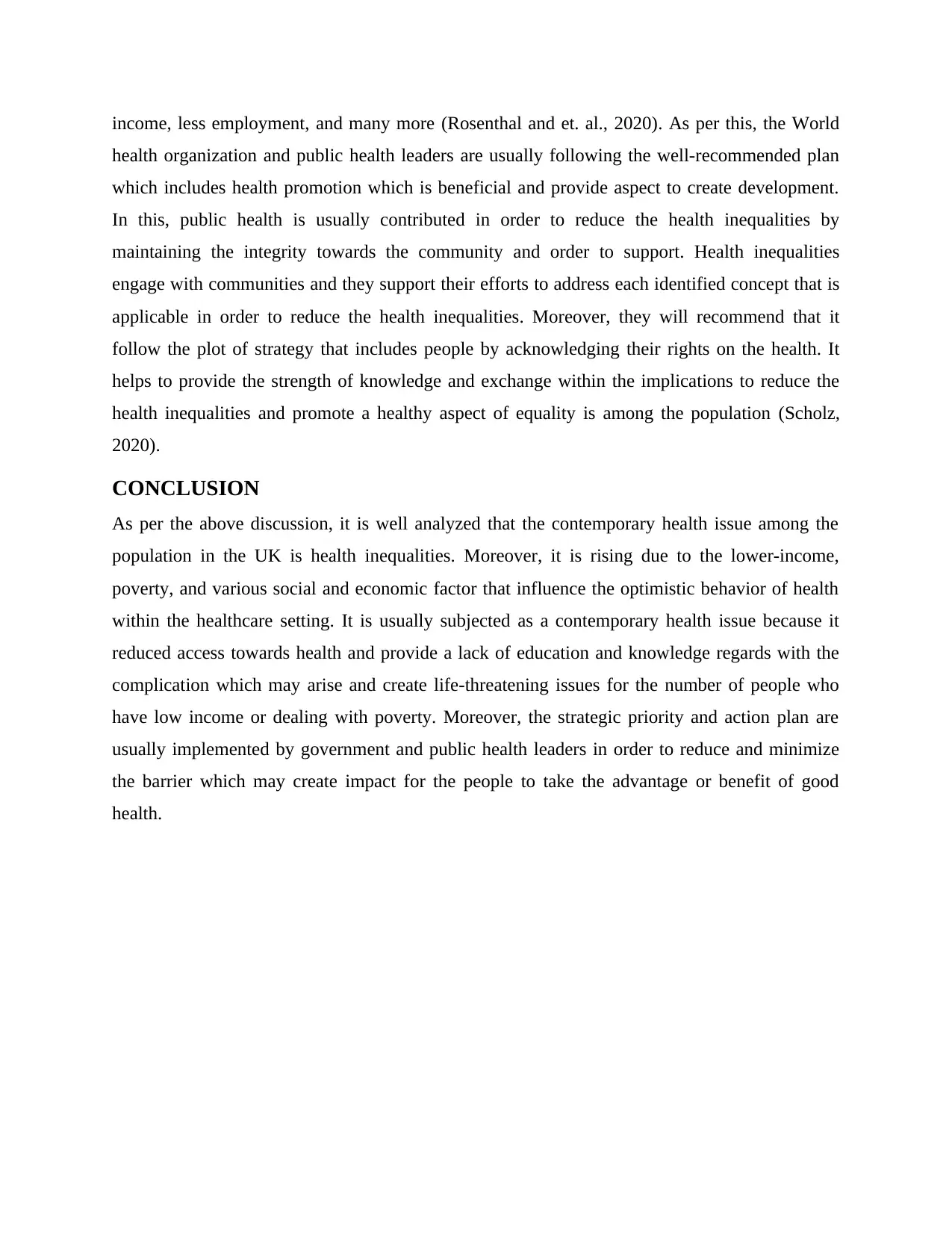
income, less employment, and many more (Rosenthal and et. al., 2020). As per this, the World
health organization and public health leaders are usually following the well-recommended plan
which includes health promotion which is beneficial and provide aspect to create development.
In this, public health is usually contributed in order to reduce the health inequalities by
maintaining the integrity towards the community and order to support. Health inequalities
engage with communities and they support their efforts to address each identified concept that is
applicable in order to reduce the health inequalities. Moreover, they will recommend that it
follow the plot of strategy that includes people by acknowledging their rights on the health. It
helps to provide the strength of knowledge and exchange within the implications to reduce the
health inequalities and promote a healthy aspect of equality is among the population (Scholz,
2020).
CONCLUSION
As per the above discussion, it is well analyzed that the contemporary health issue among the
population in the UK is health inequalities. Moreover, it is rising due to the lower-income,
poverty, and various social and economic factor that influence the optimistic behavior of health
within the healthcare setting. It is usually subjected as a contemporary health issue because it
reduced access towards health and provide a lack of education and knowledge regards with the
complication which may arise and create life-threatening issues for the number of people who
have low income or dealing with poverty. Moreover, the strategic priority and action plan are
usually implemented by government and public health leaders in order to reduce and minimize
the barrier which may create impact for the people to take the advantage or benefit of good
health.
health organization and public health leaders are usually following the well-recommended plan
which includes health promotion which is beneficial and provide aspect to create development.
In this, public health is usually contributed in order to reduce the health inequalities by
maintaining the integrity towards the community and order to support. Health inequalities
engage with communities and they support their efforts to address each identified concept that is
applicable in order to reduce the health inequalities. Moreover, they will recommend that it
follow the plot of strategy that includes people by acknowledging their rights on the health. It
helps to provide the strength of knowledge and exchange within the implications to reduce the
health inequalities and promote a healthy aspect of equality is among the population (Scholz,
2020).
CONCLUSION
As per the above discussion, it is well analyzed that the contemporary health issue among the
population in the UK is health inequalities. Moreover, it is rising due to the lower-income,
poverty, and various social and economic factor that influence the optimistic behavior of health
within the healthcare setting. It is usually subjected as a contemporary health issue because it
reduced access towards health and provide a lack of education and knowledge regards with the
complication which may arise and create life-threatening issues for the number of people who
have low income or dealing with poverty. Moreover, the strategic priority and action plan are
usually implemented by government and public health leaders in order to reduce and minimize
the barrier which may create impact for the people to take the advantage or benefit of good
health.
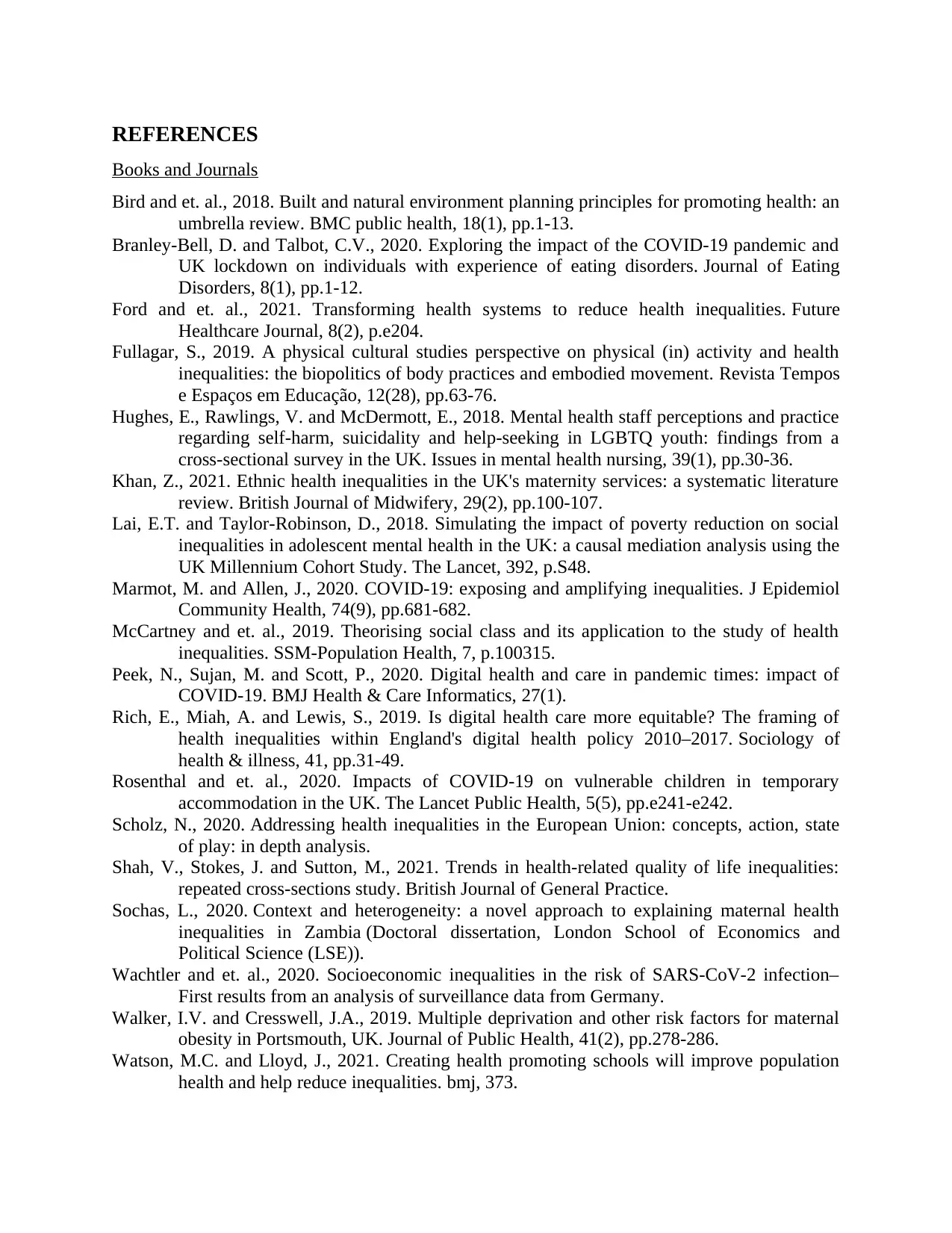
REFERENCES
Books and Journals
Bird and et. al., 2018. Built and natural environment planning principles for promoting health: an
umbrella review. BMC public health, 18(1), pp.1-13.
Branley-Bell, D. and Talbot, C.V., 2020. Exploring the impact of the COVID-19 pandemic and
UK lockdown on individuals with experience of eating disorders. Journal of Eating
Disorders, 8(1), pp.1-12.
Ford and et. al., 2021. Transforming health systems to reduce health inequalities. Future
Healthcare Journal, 8(2), p.e204.
Fullagar, S., 2019. A physical cultural studies perspective on physical (in) activity and health
inequalities: the biopolitics of body practices and embodied movement. Revista Tempos
e Espaços em Educação, 12(28), pp.63-76.
Hughes, E., Rawlings, V. and McDermott, E., 2018. Mental health staff perceptions and practice
regarding self-harm, suicidality and help-seeking in LGBTQ youth: findings from a
cross-sectional survey in the UK. Issues in mental health nursing, 39(1), pp.30-36.
Khan, Z., 2021. Ethnic health inequalities in the UK's maternity services: a systematic literature
review. British Journal of Midwifery, 29(2), pp.100-107.
Lai, E.T. and Taylor-Robinson, D., 2018. Simulating the impact of poverty reduction on social
inequalities in adolescent mental health in the UK: a causal mediation analysis using the
UK Millennium Cohort Study. The Lancet, 392, p.S48.
Marmot, M. and Allen, J., 2020. COVID-19: exposing and amplifying inequalities. J Epidemiol
Community Health, 74(9), pp.681-682.
McCartney and et. al., 2019. Theorising social class and its application to the study of health
inequalities. SSM-Population Health, 7, p.100315.
Peek, N., Sujan, M. and Scott, P., 2020. Digital health and care in pandemic times: impact of
COVID-19. BMJ Health & Care Informatics, 27(1).
Rich, E., Miah, A. and Lewis, S., 2019. Is digital health care more equitable? The framing of
health inequalities within England's digital health policy 2010–2017. Sociology of
health & illness, 41, pp.31-49.
Rosenthal and et. al., 2020. Impacts of COVID-19 on vulnerable children in temporary
accommodation in the UK. The Lancet Public Health, 5(5), pp.e241-e242.
Scholz, N., 2020. Addressing health inequalities in the European Union: concepts, action, state
of play: in depth analysis.
Shah, V., Stokes, J. and Sutton, M., 2021. Trends in health-related quality of life inequalities:
repeated cross-sections study. British Journal of General Practice.
Sochas, L., 2020. Context and heterogeneity: a novel approach to explaining maternal health
inequalities in Zambia (Doctoral dissertation, London School of Economics and
Political Science (LSE)).
Wachtler and et. al., 2020. Socioeconomic inequalities in the risk of SARS-CoV-2 infection–
First results from an analysis of surveillance data from Germany.
Walker, I.V. and Cresswell, J.A., 2019. Multiple deprivation and other risk factors for maternal
obesity in Portsmouth, UK. Journal of Public Health, 41(2), pp.278-286.
Watson, M.C. and Lloyd, J., 2021. Creating health promoting schools will improve population
health and help reduce inequalities. bmj, 373.
Books and Journals
Bird and et. al., 2018. Built and natural environment planning principles for promoting health: an
umbrella review. BMC public health, 18(1), pp.1-13.
Branley-Bell, D. and Talbot, C.V., 2020. Exploring the impact of the COVID-19 pandemic and
UK lockdown on individuals with experience of eating disorders. Journal of Eating
Disorders, 8(1), pp.1-12.
Ford and et. al., 2021. Transforming health systems to reduce health inequalities. Future
Healthcare Journal, 8(2), p.e204.
Fullagar, S., 2019. A physical cultural studies perspective on physical (in) activity and health
inequalities: the biopolitics of body practices and embodied movement. Revista Tempos
e Espaços em Educação, 12(28), pp.63-76.
Hughes, E., Rawlings, V. and McDermott, E., 2018. Mental health staff perceptions and practice
regarding self-harm, suicidality and help-seeking in LGBTQ youth: findings from a
cross-sectional survey in the UK. Issues in mental health nursing, 39(1), pp.30-36.
Khan, Z., 2021. Ethnic health inequalities in the UK's maternity services: a systematic literature
review. British Journal of Midwifery, 29(2), pp.100-107.
Lai, E.T. and Taylor-Robinson, D., 2018. Simulating the impact of poverty reduction on social
inequalities in adolescent mental health in the UK: a causal mediation analysis using the
UK Millennium Cohort Study. The Lancet, 392, p.S48.
Marmot, M. and Allen, J., 2020. COVID-19: exposing and amplifying inequalities. J Epidemiol
Community Health, 74(9), pp.681-682.
McCartney and et. al., 2019. Theorising social class and its application to the study of health
inequalities. SSM-Population Health, 7, p.100315.
Peek, N., Sujan, M. and Scott, P., 2020. Digital health and care in pandemic times: impact of
COVID-19. BMJ Health & Care Informatics, 27(1).
Rich, E., Miah, A. and Lewis, S., 2019. Is digital health care more equitable? The framing of
health inequalities within England's digital health policy 2010–2017. Sociology of
health & illness, 41, pp.31-49.
Rosenthal and et. al., 2020. Impacts of COVID-19 on vulnerable children in temporary
accommodation in the UK. The Lancet Public Health, 5(5), pp.e241-e242.
Scholz, N., 2020. Addressing health inequalities in the European Union: concepts, action, state
of play: in depth analysis.
Shah, V., Stokes, J. and Sutton, M., 2021. Trends in health-related quality of life inequalities:
repeated cross-sections study. British Journal of General Practice.
Sochas, L., 2020. Context and heterogeneity: a novel approach to explaining maternal health
inequalities in Zambia (Doctoral dissertation, London School of Economics and
Political Science (LSE)).
Wachtler and et. al., 2020. Socioeconomic inequalities in the risk of SARS-CoV-2 infection–
First results from an analysis of surveillance data from Germany.
Walker, I.V. and Cresswell, J.A., 2019. Multiple deprivation and other risk factors for maternal
obesity in Portsmouth, UK. Journal of Public Health, 41(2), pp.278-286.
Watson, M.C. and Lloyd, J., 2021. Creating health promoting schools will improve population
health and help reduce inequalities. bmj, 373.
⊘ This is a preview!⊘
Do you want full access?
Subscribe today to unlock all pages.

Trusted by 1+ million students worldwide

Wyper and et. al., 2021. Socioeconomic inequalities in COVID-19 DALYs in Scotland,
2020. European Journal of Public Health, 31(Supplement_3), pp.ckab164-210.
2020. European Journal of Public Health, 31(Supplement_3), pp.ckab164-210.
1 out of 10
Related Documents
Your All-in-One AI-Powered Toolkit for Academic Success.
+13062052269
info@desklib.com
Available 24*7 on WhatsApp / Email
![[object Object]](/_next/static/media/star-bottom.7253800d.svg)
Unlock your academic potential
© 2024 | Zucol Services PVT LTD | All rights reserved.





